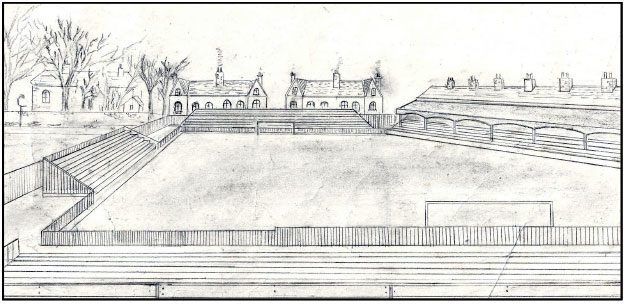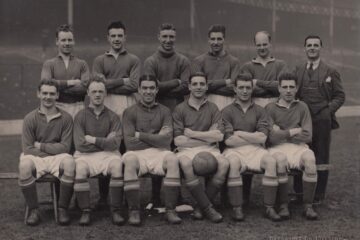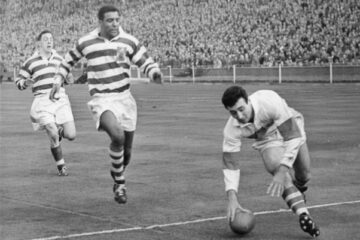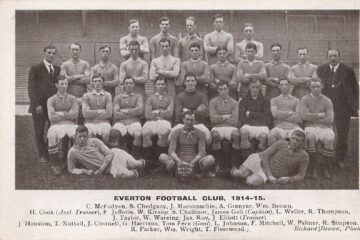
Anfield, shortly before the departure of Everton.
Jack Angus was born on 1 December 1868 in an area of central Glasgow long since given over to commerce, known as Bythswood. He first came to prominence when playing for a local junior club, Kelvingrove Athletic, against Queens Park, in a local knockout at Hampden Park. The juniors, outclassed, were beaten 7-0. Kelvingrove Athletic was then drawn against 3rd Lanark in the second round of the Scottish Cup and was beaten by eight goals to nil. Angus then joined the 3rd Lanark club from where he was offered a trial with Everton.
Angus was given a couple of days to settle in to his new environment before making his Everton debut in a friendly fixture against Burslem Port Vale. The match took place on what was, at the time, the home ground of the Staffordshire club at Colbridge. Angus, who accompanied George Farmer on the right side of the forward line, helped Everton to record a 2-1 victory. The following Saturday he took part in the reserve game against Stoke at Anfield before being thrown in at the deep end. Angus made his Everton league debut on 22 December 1888 against Preston North End at Deepdale.
The occasion attracted a crowd of around 8,000 spectators, 700 of whom had travelled there from Liverpool. Welshman Joe Davies was missing through illness and Angus replaced him on the right side of the Everton forward line. The home side proved too strong for the visitors and beat them, quite comfortably by three goals to nil. The Everton party then returned home and relaxed on Sunday, before joining the Christmas celebrations which, in terms of entertainment, would have been very different from those we recognise today.
The ‘must see a game’ football fans of Victorian Liverpool were forced to converge on Hawthorne Road, where the only match to be played on Christmas Eve took place between the Second XI of Bootle and Rawtenstall. The 200 or so who arrived there were delighted to discover that Dr John Smith, the famous Scottish international forward, was making a guest appearance in the Bootle colours (he was practicing in Liverpool at the time) and helped them to register a 3-0 win. Elsewhere in the city, the market stalls remained open until late in the evening, with some closing as late as midnight, when the church bells rang in a Christmas Day that would be a busy one for Mr John Houlding and his fellow directors.
The Everton president was reported to be up early that morning, because he had much to do. His name was on the list of local businessmen printed in a local newspaper, who were responsible for the preparation of 4,000 monster hot pots which, along with bread, tea and coal, were distributed to the poor families of Liverpool. John Houlding was also a member of the lay vestry at St Saviours church, and this was one of the places where these unfortunate people could apply for the voucher needed to obtain this festive meal. Once the food had been distributed, he hurried back to oversee the entertainment over the holiday period.
Two matches took place on Christmas Day. The first was against an Ulster Select XI who, having travelled by overnight ferry, docked in Liverpool just a few hours before the kick-off that had been arranged for 10:45am. Angus was selected to take part in the game. The association game was, in the province, still at an early stage of development so the hosts consented to allow their guests to strengthen their side with two experienced Scottish players who were residing on Merseyside. Their names were George Coyne and John Davie, and each of them had that season played two football league matches for Everton.
The gates of the Anfield enclosure were opened early, and thanks to the mild weather, around 6,000 local fans paid for admission. The game was a most sporting affair with the spirit of goodwill being shown by all concerned. Everton were leading 2-0 when their goalkeeper, Charlie Joliffe, brightened up the game by moving into the forward line. He then raised the loudest cheer of the morning by scoring a late goal, as Everton ran out winners by three goals to nil. When the crowd had dispersed, the gates of the enclosure were shut, while over at the Everton headquarters the smell of festive cooking filled the air.
The manager of the Sandon Hotel would, no doubt, have filled a flowing bowl of hot rum punch and served it, along with club members, to his guests. The Ulstermen would have then enjoyed a seasonal banquet before setting off to compete in the next leg of their tour which was to be against Southport Central. They had barely left the premises when a second party of guests arrived.

Leaving the Sandon
The Everton executive, planning well in advance, had arranged for a Lancashire Cup tie to be played that afternoon. Their opponents were to be Blackburn Park Road. George Dobson, along with Johnny Holt and George Farmer, had purposely missed the morning game in order to steady the Second XI, while Charlie Joliffe again took his place beneath the home cross bar. The mild weather had given way to a heavy downpour when Dobson led his players onto the enclosure, where a crowd of 4,000 waited to greet them. The game which followed, was spoiled by the heavy pitch but the players managed to keep the crowd entertained. The visitors, who were trailing by three goals to one, scored a late second goal and then gave the home side some anxious moments before the welcome sound of the final whistle. The Everton ground staff then had twenty four hours to prepare the pitch in readiness for the Boxing Day visit of their deadly rivals from Bootle.
The two sides had been at loggerheads for some time and this festive fixture, with the benefit of hindsight, would go someway to help them bury the hatchet. The match caught the imagination of the local football fans and over 16,000 were present when, at 2.50pm, the two teams took to the field. Jack Angus, who had never before been observed by such a multitude, would have no doubt been somewhat apprehensive as he took up his position on the right of the home forward line. The Anfield pitch was still showing the scars of the previous day’s encounter and the overnight rain had only served to make it worse. The players, during the course of game, struggled to keep their feet in the treacherous conditions and the crowd, full of Christmas spirit, roared with laughter at their antics. The heavy ground, which soon resembled a swamp, slowly sapped the energy of both sets of players and game ended in a goalless draw.
Nevertheless, after a bath and change, the players were later shown into the dining saloon, where the demands of hospitality were duly honoured. John Houlding stood sentinel as the cloth was removed from the table and the Christmas celebrations of 1888 were brought to a successful conclusion by certain members, who delighted the assembly with their musical talents. The Everton players had five days to recover in time for their next Football League match at Accrington.
The match took place on the home of Accrington Cricket Club which was known locally as Thornyholme. Angus, who was selected to play, was now switched over to the left wing, where he partnered Edgar Chadwick. The east Lancashire cotton town was, in terms of population, the smallest among the founder members of the Football League and the crowd who watched the match was described as being ‘modest in number’. George Farmer, who missed his train, failed to turn up, so Everton quickly secured the services of Pickering, who played for Bells Temperance. A first half goal scored by Edgar Chadwick brought the visitors level at the break, but the home side, with two second half goals, won the game by three goals to one. It had been another poor performance by Everton, who returned home to welcome both the New Year and their visitors from Scotland.
First to arrive were the Third Lanark VR who had, the previous day, played a football match in Manchester. The Anfield pitch, which looked anything but inviting, was occasioned by a thick frost whilst a damp mist spread a cloak over the location. Nonetheless, around 3,000 spectators chose to spend New Years Day supporting Everton. Angus, who was not selected, watched from the grandstand as his former club held Everton to a 2-2 draw. The following day, another Scottish team stepped out at Anfield.
Cambuslang were a team of players who were based at a coal mining community in North Lanarkshire. They had reached the final of the Scottish Cup the previous season but had been beaten, 6-1 by Renton. The visiting side contained members of the Gourley family, the eldest of whom, Jimmy, had previously played for Scotland. The thick fog, evident the previous day, was now reported to have got worse, and this made it difficult for the 2,500 spectators to follow the game. Angus was tried at centre forward, but failed to get on the score sheet. However, two first half goals, scored by Chadwick, were enough to give Everton a 2-1 victory.
The dreadful weather, as the game with Blackburn Rovers approached, showed no sign of yielding. The referee arrived and having inspected the frozen pitch, did not like what he saw, and spoke to representatives of both clubs. It was then decided, owing to the conditions, that whatever the result may be the match was to be declared a draw and counted accordingly. Whether or not the 6,000 spectators were aware of this arrangement is not clear, but the match went ahead all the same. Jack Angus played on the right wing as Everton, with a goal from Bob Watson won 1-0. The league committee refused to uphold this decision and ordered the match replayed. Everton won 3-1.
The weather was much improved when the next Football League game against lowly Stoke took place at Anfield, where Angus again took his place on the right of the home forward line. The visitors featured the England goalkeeper, Jack Rowley, but he could not prevent his side from sliding to a 2-1 defeat. The two points gained were welcomed by the Anfield faithful, because their next game was to be against the all-conquering Preston North End.
The Lilywhites, when they arrived in Liverpool, were champions ‘in all but name’, and they had yet to lose a Football League match. The occasion attracted a crowd of 14,000 which was, to date, the largest to watch a Football League match in England. The home side were minus their regular wing half John Weir, and his place was taken by Bob Kelso, a Scot who was playing his football with Newcastle West End. Everton matched their distinguished guests throughout the first half and held them until the break. The second half, however, belonged to the visitors and goals from Ross and Goodall gave them a 2-0 victory. Angus, it was reported, had produced some ‘good football’ in the first half and retained his place for the next league match at Wolverhampton. It was however, to be his last.
What went wrong that day has yet to be clarified, because the local newspapers failed to give a reasonable explanation. The Midland club had yet to settle on the Molineux Grounds and played their home matches on Dudley Road. It was a basic enclosure, with a pronounced slope, that had a small ‘lean to’ that ran along one touchline. There was no pavilion to hand, so the players changed at a nearby tavern called “The Fighting Cocks”. John Weir was still hors de combat*, so his place was taken by Rob Stevenson from the reserves. He was a Kilmarnock-born Scot and close associate of Sandy Dick.
[*out injured]
Nick Ross lost the toss, so Everton began the game, playing up the slope with a strong wind against them. The home forwards then laid siege to their opponent’s goal and, when the half time whistle sounded, led by four goals to nil. In the second half, Everton put up a greater resistance who, after adding a further goal, won the game by five goals to nil.
Jack Angus now found himself playing at intermittent intervals for the Everton Second XI, but he did take part in one or two notable matches with the first team. He travelled with the Everton party on their inaugural trip to Wearside, where he competed against a Sunderland side that was doing all in their power to secure membership of the Football League. Angus also represented Everton when Newton Heath made their first visit to Anfield, and took part in the game against the Scottish Cup holders, the self acclaimed world champions Renton. Angus, having played five Football League games for Everton, was not retained by the club, and left Liverpool during the summer. The rest of his career, however, is subject to debate and has yet to be confirmed.
What is certain however, is that in 1891, Angus moved to Manchester and signed for an Ardwick side that had just become members of the Football Alliance. The following season, along with Bootle, they became founder members of the Second Division of the Football League. Angus then took part in the first Football League match to be played in Manchester and scored as Ardwick beat Bootle by seven goals to nil. He played in seven Football League games for them, scoring three times, plus one FA Cup-tie, before transferring his services to Stockport County.
The next season, he moved south to become one of the first men to be employed as a professional football player by the St Mary’s club in Southampton. He made his debut on 4 November 1893 in an FA Cup-tie played on the Antelope Ground, against Uxbridge. His new employers were members of the Hampshire FA, and it was during a local knockout tournament against Freemantle that Angus, following an ‘over zealous’ tackle, became the first St Marys player to be ordered off the field. Next season, Southampton St Marys became members of the Southern League and Angus scored in their inaugural match played against Chatham Town, on the Antelope Ground. He made another fifteen appearances for the Hampshire club before leaving the area in 1896. It is believed that Jack Angus later settled in the Paddington area of London where he spent the rest of his days.



